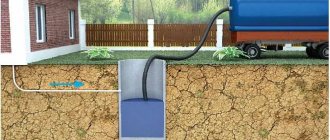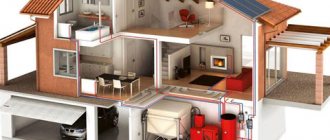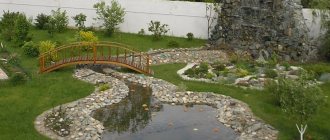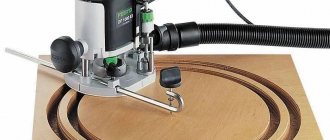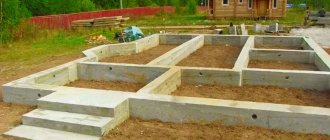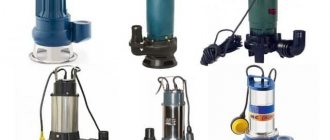The main element of autonomous water supply systems, which ensures their functioning in the required mode, is the water pump. Not only the duration of its operation without failures and frequent breakdowns, but also the efficiency of the entire system that this device serves will depend on how correctly such equipment is selected. In order for the choice of a water pump for a private home or cottage to be justified and not cause any particular difficulties, it is necessary to understand the design features, operating principle, operational and technical characteristics of various types of this device.
Surface automatic pump for watering gardens and vegetable gardens
How to water a garden
Features of summer watering
Watering is not just about moistening the soil.
When watering, the following factors must be taken into account: water temperature, groundwater depth, soil moisture, timing and norms of vegetation irrigation, irrigation goals, etc. Since water is one of the important factors in the development and growth of plants, due attention must be paid to watering.
If plants do not have enough moisture, then they form small flowers and fruits, and a lack of nutrients occurs in the tissues, which causes retarded root growth, etc.
Weakened plants do not tolerate low temperatures well, many simply freeze out.
An excess of moisture for plants is just as undesirable as its lack. With excessive moisture, plant roots begin to rot, and leaves turn yellow and fall off. Plants become unstable to diseases.
When watering, it is necessary to take into account the timing and norms of watering, soil composition, and climate.
Proper watering is the key to a good harvest.
Groundwater
The irrigation regime largely depends on how deep the groundwater lies in the area.
The best areas are those where the water is at a depth of 4 m, i.e. neither the water nor its salt composition have a negative effect on the roots of plants.
In arid areas where groundwater is fairly close and not saline, it is possible to grow excellent fruit orchards.
The worst thing is when the water lies 1-2 m from the surface. It often contains salts that poison the soil.
Chemical analysis of these soils shows that they have little oxygen and a lot of chloride-sulfate salts.
In areas where groundwater lies close, the thickness of the soil layer necessary for normal plant growth decreases.
Cold water that comes close to the root system weakens it, especially at the beginning of the growing season, and inhibits the development of plants.
The groundwater level is not the same throughout the year.
The level of groundwater can be determined using inspection wells.
Moisture in the soil
Soil moisture depends on seasonal precipitation. The accumulation of autumn-winter precipitation is especially important.
With the onset of summer, plants begin to consume more moisture, and as a result of its intense evaporation, the natural moisture of the soil decreases.
Summer precipitation is not always able to replenish the moisture deficit, especially in arid areas, since it moistens the ground only 20-30 cm deep.
Short heavy rains bring little benefit, and therefore additional watering is necessary, especially for those crops whose root systems are located in the upper layers of the soil.
➣ Soil has the following properties: water permeability (the ability of soil to conduct water through various layers, including groundwater) and water-holding capacity. The latter depends on the dispersion, mineralogical and chemical composition, as well as the humus content in the soil.
With high planting densities, especially on soils that do not retain water well, plants begin to consume a lot of moisture from all layers of the soil. In this case, only regular watering can provide the required amount of moisture.
What should be the water for watering the garden?
The quality of water and its temperature determine the growth of plants, as well as their supply of nutrients, etc. The quality of water for irrigation is determined by the degree of presence of water-soluble salts and suspended particles in it.
Water for irrigation can be taken from natural and artificial reservoirs, since it practically does not contain water-soluble salts, but at the same time it contains a large number of suspended particles.
It is not advisable to water plants with water from a well or artesian, since its temperature, even on hot days, does not exceed 8-10°C. Watering with such water will cause temperature shock in plants.
The root system will stop absorbing moisture, and the plants will not receive nutrients and water. As a result, the plants will wilt.
According to experts, the optimal water temperature for irrigation should be 15-25°C.
To heat water, containers up to 50 m3 are used (barrels, tanks, etc.). The containers are supported on high metal or brick supports so that during irrigation, water flows to the beds by gravity.
Nowadays, the most common source of water supply for sites is piped water. But since such water is highly chlorinated for disinfection purposes, it is best to leave it in containers before watering.
Norms and timing of watering the garden in summer
In order to carry out watering , you need to regularly monitor soil moisture, determine the timing and calculate the irrigation rates.
Terms and standards depend on the type and variety of crops, their age, planting density, as well as the depth of groundwater, climatic and soil conditions, etc.
To preserve moisture in the soil, they resort to moisture-saving technologies. After the top layer dries, the soil is loosened and mulched. If there are plants on the site that cannot tolerate direct sunlight, then shade them.
Watering rates and timing depend on the climate, type and age of plants, and soil type.
Thus, light soils, unlike clay soils, dry out very quickly, so during droughts watering is carried out more often.
If watering is insufficient, a crust will appear on the surface of the soil, causing the plants to form lateral surface roots.
The timing of watering is determined by the appearance of the leaves (color and partial wilting during hot hours) and soil moisture. If a lump of earth thrown from a height of about 1-1.5 m crumbles, it means the plants need watering.
Source
Irrigation pump rating
Before writing the TOP, consultations were held with sellers, and many reviews from buyers and gardeners were studied. The analysis took into account the following characteristics:
- Type – surface or submersible;
- Mechanism – centrifugal or vibration;
- Installation – horizontal or vertical;
- Manufacturing materials;
- Weight and dimensions;
- Suction depth;
- Power;
- Liquid temperature range;
- Water quality – clean or polluted;
- Mains voltage;
- Bandwidth;
- Maximum pressure;
- Operating pressure;
- Protection against splashes, drops and solid particles;
- Heat resistance;
- Noise level.
The selection also focused on safety, versatility, reliability, ease of use and value for money. After a detailed analysis and comparison of all parameters, 10 winners were selected from more than 30 nominees.
The best battery sprayers
Melt, tap or rain – choose water for watering plants
Adding an article to a new collection
Water in liquid form is simply necessary for plants to function normally. It is needed to dissolve nutrients and transport them from the depths of the soil to plant cells (the roots absorb water from the soil, and the stomata on the leaves evaporate, providing a continuous flow).
In addition, aqueous solutions provide plant tissues with turgor (that’s why they are so juicy and elastic), and water also participates in the most important process of photosynthesis for plants.
But, in addition to the time of irrigation and a certain amount of this same irrigation water for different crops at different times of their growth and maturation, an important factor for plant organisms is the temperature and “quality” of water.
With temperature, everything seems to be more or less clear - no one will water the plants with boiling water, so as not to “cook” them, or with ice water from a well, so as not to create favorable conditions for the development of underground rot. It is clear that temperature stress with any sign, “+” or “–”, will not benefit any living organism, including plants.
In addition to the actual negative temperature effect on the cells of the plant body, too cold or too hot water has a bad effect on the absorption capacity of the root system and the vital activity of soil microorganisms.
Therefore, the optimal water temperature for irrigation will be neutral in the range of 15-22°C (the so-called “room temperature”). Such indicators can be achieved by filling a large container with water from a water supply or an artesian well in the evening and allowing the liquid to settle overnight (or, depending on the temperature outside, to warm up during the day) and become a comfortable temperature for plants.
Now let’s look at the “quality” of water for irrigation – its composition and properties.
What is water from a chemical point of view? It is an inorganic compound, a transparent liquid without taste, color or odor. Water molecules consist of two hydrogen atoms and one oxygen, which are connected to each other. At low temperatures, liquid water turns into a solid state (ice), and at elevated temperatures it turns into a gaseous state (water vapor). The pH of pure water (its acidity) at a temperature of 25°C is about 7 units.
Of course, ordinary water - neither in the water supply system (from your tap), nor in a well, nor from precipitation (rainwater, snow), nor from rivers and streams - will not be perfectly chemically pure. To one degree or another, it will contain a mass of heterogeneous impurities and particles of different sizes: from dissolved mineral salts and gases to microorganisms and sand. Depending on the “content,” naturally, the acidity and hardness of the water will change in one direction or another.
Vibration and centrifugal pumps
Submersible water pumps, based on their operating principle, are divided into 2 main categories:
- Centrifugal pumps.
- Vibrating.
Vibrating devices are used to extract water from wells. These are relatively cheap pumps with low performance. Centrifugal units can be called more advanced; they are used in wells and also in wells.
These pumps are also divided into 2 subcategories:
- Screw.
- Vortex.
The pumps can be equipped with various automation elements without any particular difficulties.
How to water a garden - breaking stereotypes!
In this chapter we will talk about irrigation in natural farming. I also hope that those readers who have not switched to natural farming will be able to understand why many garden and ornamental plants suffer from ordinary watering with warm water. We will break stereotypes and look at watering plants step by step.
The printed word is a terrible force, and the unprinted word even more so! “Testaments of experienced gardeners,” which are passed down from mouth to mouth, say that you can only water with warm water. This myth is a heavy and almost invincible legacy in agriculture.
Not only do plants suffer from watering with warm water for legitimate reasons from a scientific point of view, but such watering also leaves them hungry. Physics is the science of nature. And she will help us get to the bottom of the truth.
Watering and feeding plants
The main source of plant nutrition is water. Does it sound strange? But this is a fact. Plants absorb all the necessary nutrients through their roots in the form of aqueous solutions. Without water, plants starve. Only aqueous solutions of minerals and carbon dioxide can be absorbed by the roots. In a “dry” form, they do not absorb anything.
Do not confuse natural mineralized solutions with mineral fertilizers. It's not the same thing.
Carbon dioxide is the most important element of plant nutrition. Low carbon dioxide content in the air is the main reason that limits the yield of garden and garden crops. I wrote in detail about how the yield increases by 2–3 times in the article “Natural farming, what is it?” An aqueous solution of carbon dioxide - carbon dioxide is the basis of carbon nutrition for plants.
In nature, the main suppliers of carbon nutrition are soil dew, groundwater and rain. Do you remember what raindrops taste like when you lick them from your lips? They are sour. They are acidified by carbon dioxide. This is an aqueous solution of carbon dioxide.
Due to the uninterrupted supply of an aqueous solution of carbon dioxide, plants increase their yield several times! Without interruption, carbon dioxide is supplied to plants by soil inhabitants that live in and under mulch. And water, when properly watered, turns active mulch into a super nutritious carbon cocktail for plants.
I wrote three articles about how to properly mulch the soil, how mulch becomes active and how to increase the soil population - “Mulching what is it”, “Mulching with sawdust” and “Mulching with hot grass”.
Physics is the science of nature.
Properly organized watering is the key to obtaining a large harvest. Physics will help you understand how to properly water your garden.
Carbon dioxide is highly soluble in water. And not just good, but phenomenal! The solubility of carbon dioxide in water is 150 times higher than that of nitrogen. The solubility of any gas depends on the pressure and temperature of the water.
The lower the temperature of water at constant pressure, the more gas can dissolve in it. At a water temperature of 15 degrees, 0.59 mg of carbon dioxide dissolves in 1 liter of clean water. At a temperature of 35-40 degrees, it is half as much - this is the same warm water for irrigation. In boiled water, and in water that has a temperature above 80 degrees, there is no carbon dioxide.
The conclusion suggests itself. You need to water your garden and vegetable garden with cold water. The colder the water, the more carbon dioxide dissolves in it.
Is it scary to water your plants with ice water? I was also scared at first, until I “got into” what Boris Andreevich Bublik wrote about watering and applied his knowledge in practice.
Watering with warm water is a “control shot in the head”
“Sprinkling with warm water in the heat is a well-aimed control shot in the head,” said B.A. Bublik. In hot weather, the soil surface heats up to 60–70 degrees. If the soil is dry, this is not a problem for plant roots. Dry, loose soil has very low thermal conductivity. It doesn't warm up deeply. Plant roots remain comfortably cool.
Pumps for irrigation from a barrel
Such models are suitable for pumping liquid from containers with a depth of no more than 1.8 m. They are fixed on the side of the tank and connected to the network. These units are compact, light in weight and operate quietly. The advantage of these pumps is the ability to dilute the necessary fertilizers and chemicals in a barrel before watering. The editors of Vyborexperta.Ru chose 1 winner from 5 nominees based on the best performance and reliability.
Gardena 2000/2 Li-18
The Gardena 2000/2 Li-18 cordless submersible model is powered by an 18 V (2.6 Ah) lithium-ion battery with an LED display that shows the charge. There is also a control panel with a power button and 3-level power adjustment: 1100, 1700 or 2000 l/h. Depending on the selected mode, the operating time will be 15, 30 or 60 minutes at a maximum pressure of 2, 1.3 or 0.4 bar. The maximum suction depth is 1.8 m, the minimum is 5 cm.
The design of the watering device provides the ability to connect hoses measuring 19 and 33 mm. It can be used to pump out contents from a swimming pool, submerged boat and other medium-sized containers with a maximum head of 20 m. It also supplies liquid to the shower. The highest temperature is maintained at 35°C. The device weighs little (2.5 kg) and is equipped with an adjustable curved handle. The advantage of the model is the built-in filtration system.
Advantages:
- Availability of protection against blocking of the nose impeller;
- Versatility;
- Dry running protection function;
- Unpretentiousness in maintenance;
- Charging time – 4 hours.
Flaws:
- No hoses included.
The battery that comes with the barrel pump is suitable for all Gardena equipment that supports the HeartBeat system.
The best centrifugal pumps
How to properly water plants in the garden - tips for increasing the yield
Adding an article to a new collection
The long-awaited harvest of vegetables largely depends on proper watering of the garden. If you are an inexperienced gardener and don’t know how often to water your plants, how many times to water and with what water, all the tips are in our material.
There is little moisture - the greens in the beds wither, the leaves become smaller and curl, the nightshade ovaries fall off, and the root vegetables begin to taste bitter. Too much moisture - vegetables acquire a watery taste, and the roots begin to rot. How to properly water a garden? What to do and how to avoid such troubles? Let's figure it out together.
Drip irrigation: the best special equipment
Drip irrigation is a method of spot watering plants “at the root”. Its main advantage and the reason for its development is saving water. Although the method was intended for arid regions and greenhouses, many summer residents began to install drip equipment in their homes, since it is very convenient, eliminates the need to regularly visit the site and saves the owners’ energy.
The drip irrigation system includes:
- A tape with droppers at a certain distance from each other (there may be a hose instead of a tape).
- A system of pipes and hoses supplying water to the belt.
- Valves, tees, fittings, etc.
- Plugs and filters.
- And of course, the pump.
Drip irrigation system
The following pumps are suitable for drip irrigation:
- centrifugal;
- turbine;
- deep.
A pump for drip irrigation must not only provide the required volume of water, but also have sufficient pressure. Part of it will be lost when water passes through the pipes, while working not at the limit of capabilities, but in normal mode.
To prevent the pumps from overheating from constant operation, they are grouped into stations of two pumps. And the controller turns them on and off alternately when the pressure becomes critical. The equipment wears out less.
When to water the garden?
“How many times a week should I water?” and “How often should I water?” - rhetorical questions. It all depends on your specific plot, the characteristics of the soil on it, the climatic conditions of the area, and even on what vegetables you prefer in the garden.
Below we will analyze the rules for watering certain crops, and now we will try to formulate general rules:
What time of day to water?
Water the garden in the absence of bright sun - in the morning or evening, when moisture evaporation is minimal, and water droplets will not turn into tiny scorching lenses under the sun's rays (especially during periods of very hot weather).
Morning watering is preferable in cool weather, evening watering in warm weather.
In the evening, watering should not be delayed, since if the soil does not dry out before cool twilight, this can provoke a surge in fungal diseases;
How often to water?
It is better to water less often, but more abundantly, than often, but in small portions, when the water does not have time to reach the roots;
Do I need to water the plants after transplanting?
Water – seedlings and young plants recently planted in the ground especially need life-giving moisture;
Should I water my garden after rain?
It depends on its duration and abundance - long and calm rain will help the plants much better than heavy but short rain. Stick a dry stick into the ground after precipitation, check to what depth the soil is wet - the bulk of the roots of most vegetable plants are located at a depth of 15 to 30 cm from the soil surface.
How many times a day should I water the beds?
It all depends on the weather, age and well-being of your plants - seedlings planted in the ground are watered daily, after rooting, reduce the frequency of watering to once every 2-3 days; plants in pots or in greenhouses dry faster than ground plants - they are recommended to be watered twice a day. In hot weather, of course, you will have to water more often and more than in cool weather, and areas with light sandy soils dry out much faster than clay soils.
All of the above does not apply to force majeure situations, when you have not looked at your summer cottage for a while, and upon arrival you discover that the plants frankly require immediate watering. Signs of this may be: noticeably lost turgor, drooping and lethargic (even worse, changed color) stems, leaves and buds, dried and fallen off parts of the plant.
In this case, it is vitally important to save the root system from completely drying out, so the time of day does not matter - carefully loosen the crust of dried soil at the base of the plant and water under the root, several times in small portions, so that the water saturates the soil and passes to the roots without rolling off to the sides .
Well irrigation pumps
These devices cope well with providing water supply to small private houses. They are used to collect clean water from wells, barrels and boreholes. The presence of solid particles leads to device failure. The advantage of such pumps is their large immersion depth and good pressure head. VyborExpert specialists carefully studied the characteristics of each of the 10 models considered. After comparing them, 3 winners were selected.
Livgidromash Malysh-M BV 0.12-40 10m
The submersible well pump “Livgidromash Malysh-M BV 0.12-40 10m” copes well with supplying water from wells, boreholes and ponds. He is establishing a water supply for a small house. To avoid damage, the incoming water must be clean with a maximum temperature of 35°C. It uses a vibration mechanism that ensures minimal energy consumption (240 W) and good performance (1.5 cubic m/hour).
The maximum immersion depth and pressure of the irrigation unit are 3 and 60 m. The absence of rotating parts and the use of an aluminum-silicon alloy provide reliable protection and extend its service life. The tightness of the dismountable parts of the device is maintained by securely tightened bolts. Due to the upper water intake, the device’s engine is protected from overheating and the possibility of sucking in mechanical impurities.
Advantages:
- Light weight – 3.4 kg;
- Compact dimensions – 9.9 x 25.5 cm;
- Easy installation;
- No special maintenance required;
- Protection class IPX8;
- The optimal length of the power cord is 10 m.
Flaws:
- No dry running protection.
If there is a rubber backing, the unit can operate in both vertical and horizontal positions.
Grundfos SBA 3-35 A
The Grundfos SBA 3-35 A model with a single-stage suction system descends to a depth of 10 m. The electric motor power of 800 W at a speed of 2800 rpm provides a throughput of 3000 l/h and a liquid lift of 35 m. This pump is used for watering the garden from containers, clean ponds, as well as for pumping it at temperatures up to 40°C from wells and wells. It adjusts the pressure in the water supply network and ensures the supply of liquid to private small houses.
This unit has overheating protection and is equipped with a flow switch. It features a floating suction filter made of stainless steel with 1mm perforation and a check valve. It draws in pure liquid that is below the water surface. High protection of internal elements is provided by a reliable case made of stainless steel and composite materials that are not prone to corrosion.
Advantages:
- Long cable – 15 m;
- Average dimensions – 15 x 52.8 cm;
- Light weight – 10 kg;
- Quiet operation – 50 dB;
- Protection against operation in the absence of liquid.
Flaws:
- High price.
In reviews, product owners write a lot of positive comments about its quiet operation and the presence of a suction floating filter.
Technopribor Rucheek-1, 10 m
The model “Technopribor Rucheek-1, 10 m (225 W)” with a vibration mechanism is equipped with a 225 W motor, which provides a water rise of 60 m. When lowered to a depth of 1 m, its productivity is 1050 l/h. Using the maximum capacity of 60 m, the volume of liquid supplied is reduced to 432 l/h. The unit has proven itself in collecting clean water from ponds, wells, wells and containers.
The irrigation pump has no rubbing surfaces or rotating parts, so it features uninterrupted long-term operation. The device is equipped with a thermal relay that protects the motor from overheating. An upper intake is used here, this contributes to the constant cooling of the electromagnet system. For ease of use, the device has a long cord of 10 m.
Advantages:
- Budget cost;
- Unpretentiousness in maintenance;
- Light weight – 3.6 kg;
- Compact dimensions – 10 x 28 cm;
- The best pressure indicator in the rating.
Flaws:
- Counterfeits are common.
Buyers are delighted with the high pressure that this unit provides.
What water to water the garden
The temperature and quality of irrigation water is an important factor for plants.
Why can't you water with cold water? To prevent plants from getting sick after experiencing temperature stress (the same goes for too hot water). In addition, too cold or too warm water has a bad effect on the absorption capacity of the root system and the vital activity of soil microorganisms.
Therefore, the optimal water temperature for irrigation will be neutral in the range of 15-25°C. This can be achieved by filling a large container with water from a water supply or an artesian well in the evening, letting it settle overnight (or, depending on the outside temperature, warm up during the day) and reach a temperature that is comfortable for the plant.
The optimal difference between water and air temperatures is 15-20°C. If it is exceeded, the fruits may crack and lose their presentation.
Even if it's hot outside and you think your plants will like cold water from a hose, it's best to take your time and let it warm up. Only cabbage, garlic and onions, which are cold-resistant crops, can be watered with cold water. But even in this case, we recommend not pouring water under the root, but spraying it using a diffuser.
Sedimentation of water (especially tap water, river water) will also help to precipitate or evaporate possible harmful impurities, such as chlorine, in the first case, or an abundance of suspended particles, in the second. Ordinary water for irrigation can be alternated twice with healing infusions. For example, 3 tbsp. ash per 3 liters of water or the peel of two large onions, infused for a couple of days in 3 liters of water.
You can also use rainwater for irrigation, but only if there are no industrial facilities near your site. Otherwise the water will be contaminated.
For what purposes which pump should you choose?
In order to choose a pump, you need to decide on the purpose: what you need it for. After that we move on to class. For example, for watering garden beds when using a local reservoir with significant water pollution, it is better to use submersible drainage pumps. Such pumps will also successfully drain basements and cellars flooded with water. They will also do an excellent job of removing contaminated water from small ponds, wells, and sewer pits (see how to make a sewer here).
If you intend to pump clean water, then submersible pumps (well or borehole type) or surface pumps are suitable. Moreover, they are capable of supplying water both to the water supply and to the irrigation system for watering plants. Someone may need to pump a large amount of water through a plumbing or heating system - and here you can’t do without the help of circulation pumps.
Among other things, pumps can be divided into two more classes: household and professional. Agree, for a small country residence a device that distills 50-60 liters per minute will be sufficient, but for production needs large capacities will be needed - several thousand liters.
An important factor in choosing a pump is its energy source. If you have access to the power grid, that's one question. And if the installation is located far from a stationary source of electricity, then you should choose autonomous pumps running on gasoline or diesel fuel. Such units were adopted by firefighters, rescuers and utility workers.
Watering vegetables in open ground
Let's look at the watering requirements for some of the most common vegetable crops.
There are 4 groups of vegetables based on their ability to absorb water. For ease of remembering, we have placed them in a table.
| Group | Water requirement | Name of crops |
| 1 | They use up water quickly; fractional but frequent watering is required. | Cabbage, cauliflower, Chinese cabbage, kohlrabi, lettuce, radish, cucumber, spinach, celery |
| 2 | They have a developed root system and are able to extract water at a depth of up to 80 cm. Moisture consumption is economical, so frequent watering is not required. | Tomatoes, carrots, melons |
| 3 | They use water sparingly, although it is not easy for them to extract it from the soil. They need watering only during the first half of growth. | Onions, spring onions, garlic and other onion crops |
| 4 | Absorbs water well and uses it intensively. Responds gratefully to irrigation. | Beet |
Surface irrigation pumps
Such models are mounted on the surface of the earth near the source. They are suitable for use with relatively clean water that is free of solid particles and organic debris. They are used to water gardens and provide water to homes. These devices are easy to install and move, have low power and are affordable. After testing 10 nominees, 3 winners were selected based on best performance and security.
ESPA Aspri 25 5M
The Spanish model of the surface type “ESPA Aspri 25 5M” is suitable for watering the garden and garden, increasing the pressure in the system and for supplying water to the house. Clean and slightly contaminated liquid (there is a cutting attachment) can be supplied from a pond, storage tank, water supply and well. With an average power of 1.7 kW, the unit has a high throughput of 7.2 cubic meters. m/hour and produces a good head of 56 m. It uses a centrifugal mechanism with a working pressure of 6 bar, providing the greatest suction depth of 9 m.
The minimum temperature of the pumped liquid in a water pump for watering a garden is +4°C, the maximum is up to +35°C. It is characterized by high strength indicators, as stainless steel, aluminum and reinforced plastic were used for manufacturing. An asynchronous two-pole motor with a rated speed of 2900 rpm and soft start is installed here. It is cooled by a fan built into the shaft, has a high thermal resistance class of winding insulation (F) and is protected against drops, splashes and penetration of solid objects of class IP 44.
Advantages:
- Low noise level – 58 dB;
- Wide range of maintained liquid temperature;
- The pressure and suction pipes are made of cast iron;
- Warranty period – 3 years;
- The presence of a self-priming valve;
- Rapid rise of liquid - about 3 minutes.
Flaws:
- No cable included.
Manufacturers equipped the shaft with a graffito-steatite mechanical seal, thereby ensuring the ability of the engine to operate at high temperatures and high pressure, as well as minimizing the risk of fluid leakage.
Whirlwind PN-370
...I use the Whirlwind PN-370 unit to pump liquid from a pond located next to the dacha. I am satisfied with its good performance - there is enough water to water trees and plants in a garden of 10 acres...
Expert opinion
With an average power of 370 W and modest dimensions (30.1 x 14.5 x 16.2 cm), this surface unit is capable of pumping water from a depth of up to 9 m and raising it to a height of up to 30 m. It is characterized by a throughput capacity of 2.76 cubic meters. m/h. For reliable installation during operation, the structure is provided with a strong flat base. The unit supplies liquid from a well, well, pond, pool and various storage tanks.
The Whirlwind PN-370 model combines the practicality of self-priming and the advantages of centrifugal devices, thanks to the built-in ejector with a Venturi pipe system. Also, its presence allows you to pump liquid containing solid particles, the concentration of which should not exceed 150 g/m3. For the manufacture of the device body, cast iron was used, which reliably protects all internal components from external influences and allows pumping in a temperature range from +1 to 50°C. The optimal weight of the model (5.4 kg) allows you to easily carry it.
Advantages:
- Low energy consumption;
- Budget cost;
- Motor overload protection;
- Compactness;
- Reliable design.
Flaws:
- Not very good paint quality.
Quattro Elementi Giardino 401 Ci
The surface watering unit “Quattro Elementi Giardino 401 Ci” has compact dimensions of 26 x 13 x 16 cm and a light weight of 4.6 kg. It is ideal for transportation and moving. The body is made of cast iron, which provides protection against corrosion, reduced noise during operation and a long service life. 2 legs with holes are built into its lower part, which facilitate the firm installation of the unit on the surface. The temperature of the suction liquid must be between +5 and +30°C.
This representative of the best irrigation pumps uses a centrifugal operating principle with a single-stage suction system. An electric motor with a rated power of 400 W is installed here. It is enough to provide a throughput of 2.1 cubic meters per hour at a pressure of 1.5-3 bar, as well as a maximum pressure of 32 m and a depth of 8 m. This water unit is suitable for organizing a clean water irrigation system in garden plots.
Advantages:
- Low noise level – 75 dB;
- Protection class IP54;
- Easy to use;
- High build quality;
- Ergonomics.
Flaws:
- Warranty period – 1 year.
To avoid damage to the device, be sure to check the contents in the pump and suction pipe before turning it on. It must be drained before the end of the season, as the cast iron may rust and the nose impeller may jam.
The best sprinklers
Watering vegetables in a greenhouse
Watering in a greenhouse has its own nuances. Yes, it should also be carried out during a period when the sun is not too active, yes, the frequency of watering also depends on the type of soil and the type of plant. However, we have already mentioned that greenhouse plants require more water than those in open ground, since due to the increased temperature the stems and leaves wither faster. Because of this same internal “climate,” more heated water can be used in the greenhouse for irrigation than outside on the site.
In addition, if there is excessive or improper watering, excess condensation may form inside the greenhouse - do not forget to ventilate the greenhouse after watering. Spot watering (bottle irrigation) will also help reduce the volume of condensate.
Watering cucumbers and tomatoes in a greenhouse, in principle, is not particularly different from that in open ground - monitor the soil moisture and the appearance of the plants.
Water cucumbers before flowering once every 5-7 days, and after - once every 2-3 days at the rate of about 10-20 liters per 1 sq.m. We remind you that cucumbers like to be watered at the root, and the water must be warm enough, otherwise it can provoke the appearance of fungal diseases.
Tomatoes in a greenhouse should not be watered in the first week after planting seedlings. Then water them every 3-7 days (more often in hot weather). Before flowering, this is done at the rate of 4-5 liters of water per bush, and after planting flower clusters - 1-2 liters. Increase the watering rate again to 3-5 liters already during fruit set.
Tomatoes should not be watered on the leaves, otherwise the plants will be poorly pollinated, the fruits will fall off, and there will be a high probability of infection with brown spot.
It is most convenient to water plants in a greenhouse or greenhouse using a watering can with a nozzle - this way the plants below and above on the racks will receive the right amount of moisture. If the area is large, automatic irrigation systems are needed. Of these, the drip type is considered the most economical for greenhouses, and the rain type is the most technologically complex. We will tell you what this is below.
If the greenhouse is too hot, hose down the paths with cold water. This will help lower the air temperature a little.
Advantages of submersible pumps
The dacha can be supplied with water using a well installed on the site using a conventional pumping station, or a special submersible pump. Both options have certain advantages and disadvantages that should always be taken into account when designing a water supply system for a country house.
For what reasons do submersible pumps become the most optimal devices:
- Surface pumps have certain limitations on the depth of liquid suction. Often this figure varies from 7 to 8 meters. If a horizontal pipeline is connected to such a device, stretched from the source to the pump, the actual suction depth may be significantly less. This often means the need to spend additional money on arranging a caisson to install a pumping station near the well. With submersible pumps, such difficulties never arise.
- Submersible water pumps will not make noise during operation, since they are located deep enough in the well.
- Submersible technology for wells is not so picky about the quality of the pumped liquid. Most of them can work normally with fine suspended matter, the possibility of the formation of which is always present during the operation of conventional wells.
- The probability of overheating of the device drive always remains minimal if the water source flow is sufficient. The pumped flow performs the additional function of cooling the device.
- With submersible pumps, it is much easier to monitor the current water level at the source using a specially built-in float switch. Similar mechanisms are present on most modern water pumps.
- The operation of surface pumps implies certain requirements for the tightness of the water intake pipe. Air will be sucked into the system if there is at least a minimal leak in the pipe or a crack that is difficult to visually identify. A submersible pump will never suck in air because it is completely absent from the working environment.
- When it is necessary to leave the cottage unattended for a long time, removing and removing the submersible pump will be much easier than removing the pumping device from the caisson or other room provided for it.
Submersible pumps have many advantages, so experts recommend using such devices.
Open waters
Taking water from open bodies of water such as a pond or lake or stream is one of the most rarely used methods of obtaining water for irrigation, and often only because such bodies of water are rarely found on sites. However, in reservoirs located on the border with the site or on the site itself, the best water for plants. Reservoirs “cook” water naturally. The water in them has all the beneficial properties necessary for plants. The water is heated, settled, saturated with ozone and contains a lot of organic matter.
DISC FILTER.
The disc filter for coarse water purification includes special discs made of high-strength plastic. The discs have specially applied grooves that, when the discs are compressed, form thin holes. It is through them that the process of water filtration occurs. All contaminants remain on the inner surface of the discs, from where they are then removed by washing.
The body of disk filters for mechanical water purification is also made of plastic, so it is not subject to corrosion and does not collapse during long-term use.
Disc filters are used for coarse (preliminary) cleaning and as mud collectors in various industries, water preparation and purification systems, water mains and cooling systems, to protect heat exchangers and cooling towers from mechanical impurities.
Washing disc filters is simple and easy to use, which is the most important advantage of this type of filter compared to certain models of mesh filters.
For the same reasons, filters for irrigation systems are made of frost-resistant materials, but you should not rely on this, because... In winter, remaining water in the system can tear plastic equipment due to expansion, so be sure to always drain the system and bleed it out for the winter. Be sure to drain! Better yet, empty the pipes under pressure. You can carry out maintenance yourself, and in this article we will tell you in detail how to do this.
So, water can be divided according to the degree of contamination into several stages according to the size of the dirt particles. Filters are also divided according to the size of the dirt particles that they are able to trap. The stages of purification can be clearly seen in drinking water purification systems. There is mechanical, chemical and biological cleaning, and thus a significantly large complex of various equipment is collected. When watering, such high-quality water purification is not required - it is enough to retain fine sand so that it does not forget the small holes in the valves and nozzles.
In suburban areas, water is usually supplied centrally and has a sufficient degree of purification. In this case, water purification can be limited to a simple irrigation filter of fine mechanical purification, such as a disk or mesh.
How much does a water pump cost?
Pump prices largely depend on the manufacturer. An inexpensive irrigation pump can be purchased from domestic manufacturers.
For example, popular water pumps for watering a vegetable garden (made in the CIS) “Kids” and “Rucheyki” can be bought for 1600 - 2500 rubles. Next in price are the Zubrov models, from 2500 to 3500 rubles.
Pumps NEOCLIMA, Whirlwind, QUATTRO are located in the price niche from 3000 to 4000 rubles.
High-quality, reliable Karchers and Gardens for watering cost 4,000 - 10,000 rubles, but have the most complete equipment.
It turns out that there is no single decision about which pump is better. Drainage pumps can handle any water, even dirty water, but their pressure may not be enough to water the garden. Surface pumps are more powerful than drainage pumps, but they require special installation conditions, and great depths may be too much for them. Deep models are the most universal, but they also need to be selected for specific conditions.
Despite the apparent inconvenience, watering from a barrel has many advantages - warm water is much healthier for plants than ice water directly from a well. Pump for watering a garden from a barrel: review of models and prices, as well as owner reviews about use.
Do you know what a water storage tank is used for? You can read about this in this article.

